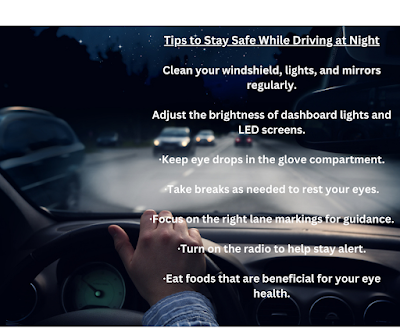Monday, April 28, 2025
Eye Can Quote You
Tuesday, April 22, 2025
Observe Earth Day to Protect Vision
April 22nd is the day Earth Day is observed annually. It was first celebrated in 1970 to promote environmental protection and is now recognized in 192 countries.
Extreme weather changes due to climate change have several negative effects on our health. Climate change contributes to:
· Wildfires
· Air pollution
· Prolonged allergy seasons
· UV damage from the depletion of the ozone layer
Wildfires can severely damage the eyes due to particulate matter made up of particles, embers, heavy metals, organic microorganisms, water vapor, and gases—many of which are toxic because wildfires burn everything in their path. Some of these particles are too small to be seen with the naked eye. Short-term effects of wildfires on the eyes include burning, stinging, tearing, and redness. Long-term effects can lead to dry eye syndrome, allergies, conjunctivitis, corneal damage, keratitis, and the aggravation of pre-existing conditions.
Air pollution arises from human civilization, industrialization, and globalization. Particulate matter (PM), nitrogen oxides (NOx), and carbon dioxide (CO2) are the primary contributors to air pollution, all of which have been proven to be harmful to human eyes.
Climate change has also caused prolonged allergy seasons. Rising temperatures attributed to climate change lead to longer allergy seasons, resulting in alarming and severe allergy events. These worsening allergy seasons can severely impact the eyes and overall quality of life. Some of the short-term effects of allergies on the eyes include:
· Itchiness
· Redness
· Watery eyes
· Blurred vision
UV damage to the eyes occurs due to the loss of ozone. The ozone layer acts as the planet's sunscreen, protecting us from the harmful effects of UV light from the sun. A significant decrease in ozone leads to more UV-B radiation reaching the Earth's surface, which can damage the eyes. Excessive exposure increases the risk of developing eye conditions such as:
· Cataracts
· Eye cancers
· Growths on the eye
· Snow blindness
· Sunburned eyes
Earth Day is observed on April 22 and should be recognized every day. If everyone does their part to protect the environment, we could help reverse some of the pollutants that negatively affect our eyes.
Sources:
#PearleVisionRobinson
#DrClaudiaWendel
#PittsburghOptometrist
#PittsburghEyeCare
Monday, April 14, 2025
FAQs for Those Considering Contact Lenses
- Do I need an exam for contact lenses? Yes, you need a contact lens exam to get a prescription and ensure a proper fit. As contact lenses are medical devices, they require specialized fitting. You will get instructions on how to put in and take out your lenses and care for them. Contacts do come in different sizes.
- Can I use my eyeglass prescription for contacts? No, because contacts require additional measurements for a proper fit. Glasses and contacts are different distances from the eye.
- If I need bifocals, can I still wear contact lenses? Yes, there are different options for different people. Between the three available options, there is a way to make contacts work for near and distant vision.
- Can I use eyedrops while wearing contact lenses? Yes, you can use certain types of eyedrops with contact lenses and use eyedrops that say "safe for use with contact lenses". It is always best to consult with your doctor to make sure the drops you are using are the right product for your needs.
- Do I need to replace my contacts on a routine schedule even if they feel comfortable? Yes, you should replace your contact lenses according to the recommended schedule, even if they feel fine to prevent issues such as infection.
- What are contact lenses made of? There are various materials available in the manufacturing of contact lenses. Soft contacts are primarily made from hydrogel or silicone hydrogel. Hard contacts or a rigid gas permeable substance. There are hybrid lenses that offer the best of both hard and soft lenses.
Sources:
www.vsp.com
www.allaboutvision.com
www.warbyparker.com
www.visionsource.com
www.coopervision.com
#PearleVisionRobinson
#DrClaudiaWendel
#PittsburghOptometrist
#PittsburghEyeCare
Wednesday, April 9, 2025
Papilledema
- Malignant hypertension
- Tumors
- Head injuries
- Infections, bleeding, or inflammation in the brain or meninges (the protective tissues surrounding the brain and spinal cord)
- Tinnitus (ringing or noise in the ears)
- Encephalitis (inflammation of the brain. It can be caused by viral or bacterial infections, or by immune cells mistakenly attacking the brain).
- Meningitis
- Blood clots in the brain
- Iron deficiency anemia
- Certain medications
- Idiopathic intracranial hypertension, where no identifiable cause is found.
Wednesday, April 2, 2025
Tips to Stay Safe While Driving at Night
- Clean your windshield, lights, and mirrors regularly.
- Adjust the brightness of dashboard lights and LED screens.
- Keep eye drops in the glove compartment.
- Take breaks as needed to rest your eyes.
- Focus on the right lane markings for guidance.
- Turn on the radio to help stay alert.
- Eat foods that are beneficial for your eye health.
The Science of Sunglasses
On a bright, sunny day, many people grab their sunglasses without considering the science behind them. When buying a new pair of shades, m...

-
The World Health Organization's World "No Tobacco Day" occurs on May 31st every year. It was created to bring awareness to m...
-
Earlier this year, in April, I posted about a nationwide recall of eye drops, by the Food and Drug Administration (FDA). The FDA has now ...
-
On a bright, sunny day, many people grab their sunglasses without considering the science behind them. When buying a new pair of shades, m...







